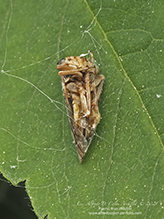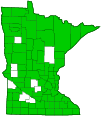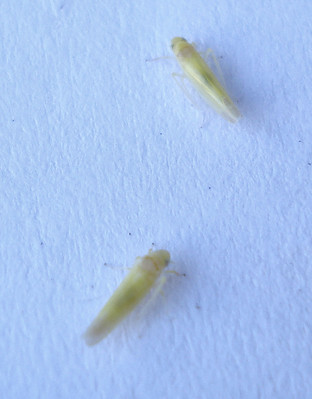typical leafhoppers
(family Cicadellidae)
Overview • Description • Distribution • Taxonomy
Some typical leafhopper species feed on a broad diversity of plants, but most species are restricted to a single species or genus of plants. All species have piercing-sucking mouthparts which they use to puncture tender plant tissue, inject saliva, and suck up plant juices. The larger species are twig feeders and suck up sap. They cause no noticeable damage to the host plant. The smaller species are leaf feeders and suck up cell contents. They leave pale spots called hopperburn on the upper side of a leaf, but no damage is visible on the underside. Some typical leafhoppers are known to transmit plant pathogens, including viruses, phytoplasms, and bacteria. Some of these species are serious agricultural pests. Unlike other insects, typical leafhoppers usually run sideways. When disturbed on a leaf or a twig, they usually dart to the other side. When disturbed on a flat surface, they run at an oblique angle. |
||
Description |
||
Typical leafhoppers are small, hard bodied, jumping insects. They range from 1⁄16″ to 1 3⁄16″ (2 to 30 mm) in length, but most are less than ⅜″ (10 mm) in length. The antennae are very short and have a stiff bristle (arista) at the end. There are two large compound eyes on the sides of the head and two small simple eyes (ocelli) on top of the head. The ocelli are well separated from the compound eyes. On the hind legs, the fourth segment (tibia) has one or two rows of small spines. The last part of all legs (tarsus), corresponding to the foot, has three segments. |
||
Distribution |
||||
|
Sources Medler, John T. (1942). The leafhoppers of Minnesota. University of Minnesota. Minnesota Agricultural Experiment Station. Retrieved from the University of Minnesota Digital Conservancy, https://hdl.handle.net/11299/204089. |
|||
| 10/30/2023 | ||||
Taxonomy |
|||
Order |
Hemiptera (True bugs, Hoppers, Aphids, and Allies) | ||
Suborder |
Auchenorrhyncha (true hoppers) | ||
Infraorder |
Cicadomorpha (spittlebugs, cicadas, leafhoppers and treehoppers) | ||
Superfamily |
Membracoidea (leafhoppers and treehoppers) | ||
Subordinate Taxa |
|||
Flat-headed Leafhoppers (subfamily Ledrinae) leafhoppers (subfamily Aphrodinae) leafhoppers (subfamily Bathysmatophorinae) leafhoppers (subfamily Coelidiinae) leafhoppers (subfamily Deltocephalinae) leafhoppers (subfamily Errhomeninae) leafhoppers (subfamily Euacanthellinae) leafhoppers (subfamily Eurymelinae) leafhoppers (subfamily Evacanthinae) leafhoppers (subfamily Hylicinae) leafhoppers (subfamily Iassinae) leafhoppers (subfamily Jascopinae) [extinct] leafhoppers (subfamily Megophthalminae) leafhoppers (subfamily Mileewinae) leafhoppers (subfamily Nastlopiinae) [extinct] leafhoppers (subfamily Neobalinae) leafhoppers (subfamily Neocoelidiinae) leafhoppers (subfamily Nioniinae) leafhoppers (subfamily Phereurhininae) leafhoppers (subfamily Portaninae) leafhoppers (subfamily Signoretiinae) leafhoppers (subfamily Tartessinae) leafhoppers (subfamily Ulopinae) Microleafhoppers (subfamily Typhlocybinae) Sharpshooters (subfamily Cicadellinae) |
|||
Synonyms |
|||
|
|||
Common Names |
|||
leafhoppers typical leafhoppers |
|||
Glossary
Arista
A large bristle on the upper side of the third segment of the antenna of a fly. Plural: aristae.
Ocellus
Simple eye; an eye with a single lens. Plural: ocelli.
Tarsus
On insects, the last two to five subdivisions of the leg, attached to the tibia; the foot. On spiders, the last segment of the leg. Plural: tarsi.
Tibia
The fourth segment of an insect leg, after the femur and before the tarsus (foot). The fifth segment of a spider leg or palp. Plural: tibiae.
Visitor Photos |
|||||
Share your photo of this insect. |
|||||
| This button not working for you? Simply email us at info@MinnesotaSeasons.com. Attach one or more photos and, if you like, a caption. |
|||||
Alfredo Colon |
|||||
 |
|||||
MinnesotaSeasons.com Photos |
|||||
|
|||||

Visitor Videos |
|||
Share your video of this insect. |
|||
| This button not working for you? Simply email us at info@MinnesotaSeasons.com. Attach a video, a YouTube link, or a cloud storage link. |
|||
Other Videos |
|||
| Leafhopper Nymph (Cicadellidae) - Beautiful, tiny bug with a tail of white feathers. Costa Rica Nature Photography |
|||
About
Sep 21, 2021 This is a leafhopper in the nymph stage. These are from the family Cicadellidae but I have no idea what exact species this one is. I was struck by the way this amazing insect moved and of course, that beautiful white feather tail. Enjoy! |
|||
| Leafhopper species black (Cicadellidae) DiegoDCvids |
|||
About
Jun 4, 2014 Cicadellidae, Membracoidea, Cicadomorpha, Auchenorrhyncha, Hemiptera |
|||

Created: 10/30/2023
Last Updated:




